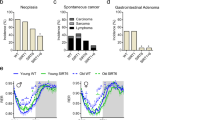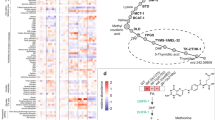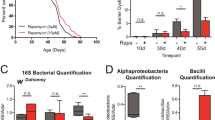Abstract
Resveratrol (3,5,4′-trihydroxystilbene) extends the lifespan of diverse species including Saccharomyces cerevisiae, Caenorhabditis elegans and Drosophila melanogaster. In these organisms, lifespan extension is dependent on Sir2, a conserved deacetylase proposed to underlie the beneficial effects of caloric restriction. Here we show that resveratrol shifts the physiology of middle-aged mice on a high-calorie diet towards that of mice on a standard diet and significantly increases their survival. Resveratrol produces changes associated with longer lifespan, including increased insulin sensitivity, reduced insulin-like growth factor-1 (IGF-I) levels, increased AMP-activated protein kinase (AMPK) and peroxisome proliferator-activated receptor-γ coactivator 1α (PGC-1α) activity, increased mitochondrial number, and improved motor function. Parametric analysis of gene set enrichment revealed that resveratrol opposed the effects of the high-calorie diet in 144 out of 153 significantly altered pathways. These data show that improving general health in mammals using small molecules is an attainable goal, and point to new approaches for treating obesity-related disorders and diseases of ageing.
This is a preview of subscription content, access via your institution
Access options
Subscribe to this journal
Receive 51 print issues and online access
$199.00 per year
only $3.90 per issue
Buy this article
- Purchase on Springer Link
- Instant access to full article PDF
Prices may be subject to local taxes which are calculated during checkout




Similar content being viewed by others
References
Olshansky, S. J. Projecting the future of U.S. health and longevity. Health Aff. (Millwood) 24, (suppl. 2)W5R86–W5R89 (2005)
Li, Z., Bowerman, S. & Heber, D. Health ramifications of the obesity epidemic. Surg. Clin. North Am. 85, 681–701 (2005)
Ingram, D. K. et al. Development of calorie restriction mimetics as a prolongevity strategy. Ann. NY Acad. Sci. 1019, 412–423 (2004)
Sinclair, D. A. Toward a unified theory of caloric restriction and longevity regulation. Mech. Ageing Dev. 126, 987–1002 (2005)
Guarente, L. & Picard, F. Calorie restriction—the SIR2 connection. Cell 120, 473–482 (2005)
Howitz, K. T. et al. Small molecule activators of sirtuins extend Saccharomyces cerevisiae lifespan. Nature 425, 191–196 (2003)
Wood, J. G. et al. Sirtuin activators mimic caloric restriction and delay ageing in metazoans. Nature 430, 686–689 (2004)
Viswanathan, M., Kim, S. K., Berdichevsky, A. & Guarente, L. A role for SIR-2.1 regulation of ER stress response genes in determining C. elegans life span. Dev. Cell 9, 605–615 (2005)
Jarolim, S. et al. A novel assay for replicative lifespan in Saccharomyces cerevisiae.. FEMS Yeast Res. 5, 169–177 (2004)
Valenzano, D. R. et al. Resveratrol prolongs lifespan and retards the onset of age-related markers in a short-lived vertebrate. Curr. Biol. 16, 296–300 (2006)
Picard, F. et al. Sirt1 promotes fat mobilization in white adipocytes by repressing PPAR-γ. Nature 429, 771–776 (2004)
Chen, J. et al. SIRT1 protects against microglia-dependent amyloid-β toxicity through inhibiting NF-κB signaling. J. Biol. Chem. 280, 40364–40374 (2005)
Kolthur-Seetharam, U., Dantzer, F., McBurney, M. W., de Murcia, G. & Sassone-Corsi, P. Control of AIF-mediated cell death by the functional interplay of SIRT1 and PARP-1 in response to DNA damage. Cell Cycle 5, 873–877 (2006)
Raval, A. P., Dave, K. R. & Perez-Pinzon, M. A. Resveratrol mimics ischemic preconditioning in the brain. J. Cereb. Blood Flow Metab. 26, 1141–1147 (2006)
Frescas, D., Valenti, L. & Accili, D. Nuclear trapping of the forkhead transcription factor FoxO1 via Sirt-dependent deacetylation promotes expression of glucogenetic genes. J. Biol. Chem. 280, 20589–20595 (2005)
Denu, J. M. The Sir2 family of protein deacetylases. Curr. Opin. Chem. Biol. 9, 431–440 (2005)
Weindruch, R. & Walford, R. L. Dietary restriction in mice beginning at 1 year of age: effect on life-span and spontaneous cancer incidence. Science 215, 1415–1418 (1982)
Siebler, J. & Galle, P. R. Treatment of nonalcoholic fatty liver disease. World J. Gastroenterol. 12, 2161–2167 (2006)
Scrocchi, L. A. & Drucker, D. J. Effects of aging and a high fat diet on body weight and glucose tolerance in glucagon-like peptide-1 receptor-/- mice. Endocrinology 139, 3127–3132 (1998)
McCarty, M. F. Chronic activation of AMP-activated kinase as a strategy for slowing aging. Med. Hypotheses 63, 334–339 (2004)
Apfeld, J., O’Connor, G., McDonagh, T., DiStefano, P. S. & Curtis, R. The AMP-activated protein kinase AAK-2 links energy levels and insulin-like signals to lifespan in C. elegans.. Genes Dev. 18, 3004–3009 (2004)
Zang, M. et al. Polyphenols stimulate AMP-activated protein kinase, lower lipids, and inhibit accelerated atherosclerosis in diabetic LDL receptor-deficient mice. Diabetes 55, 2180–2191 (2006)
Nisoli, E. et al. Calorie restriction promotes mitochondrial biogenesis by inducing the expression of eNOS. Science 310, 314–317 (2005)
Lopez-Lluch, G. et al. Calorie restriction induces mitochondrial biogenesis and bioenergetic efficiency. Proc. Natl Acad. Sci. USA 103, 1768–1773 (2006)
Wu, Z. et al. Mechanisms controlling mitochondrial biogenesis and respiration through the thermogenic coactivator PGC-1. Cell 98, 115–124 (1999)
Yoon, J. C. et al. Control of hepatic gluconeogenesis through the transcriptional coactivator PGC-1. Nature 413, 131–138 (2001)
Rodgers, J. T. et al. Nutrient control of glucose homeostasis through a complex of PGC-1α and SIRT1. Nature 434, 113–118 (2005)
Lerin, C. et al. GCN5 acetyltransferase complex controls glucose metabolism through transcriptional repression of PGC-1α. Cell Metab. 3, 429–438 (2006)
Cheadle, C., Vawter, M. P., Freed, W. J. & Becker, K. G. Analysis of microarray data using Z score transformation. J. Mol. Diagn. 5, 73–81 (2003)
Baur, J. A. & Sinclair, D. A. Therapeutic potential of resveratrol: the in vivo evidence. Nature Rev. Drug Discov. 5, 493–506 (2006)
Kim, S. Y. & Volsky, D. J. PAGE: parametric analysis of gene set enrichment. BMC Bioinformatics 6, 144 (2005)
Subramanian, A. et al. Gene set enrichment analysis: a knowledge-based approach for interpreting genome-wide expression profiles. Proc. Natl Acad. Sci. USA 102, 15545–15550 (2005)
Feng, J., Bussiere, F. & Hekimi, S. Mitochondrial electron transport is a key determinant of life span in Caenorhabditis elegans.. Dev. Cell 1, 633–644 (2001)
Kenyon, C. A conserved regulatory mechanism for aging. Cell 105, 165–168 (2001)
Kapahi, P. et al. Regulation of lifespan in Drosophila by modulation of genes in the TOR signaling pathway. Curr. Biol. 14, 885–890 (2004)
Kaeberlein, M. et al. Regulation of yeast replicative life span by TOR and Sch9 in response to nutrients. Science 310, 1193–1196 (2005)
Ingram, D. K. et al. Calorie restriction mimetics: an emerging research field. Aging Cell 5, 97–108 (2006)
Hipkiss, A. R. Does chronic glycolysis accelerate aging? Could this explain how dietary restriction works?. Ann. NY Acad. Sci. 1067, 361–368 (2006)
Taub, R. Liver regeneration: from myth to mechanism. Nature Rev. Mol. Cell Biol. 5, 836–847 (2004)
Xu, X. & Sonntag, W. E. Growth hormone-induced nuclear translocation of Stat-3 decreases with age: modulation by caloric restriction. Am. J. Physiol. 271, E903–E909 (1996)
Wilsey, J. & Scarpace, P. J. Caloric restriction reverses the deficits in leptin receptor protein and leptin signaling capacity associated with diet-induced obesity: role of leptin in the regulation of hypothalamic long-form leptin receptor expression. J. Endocrinol. 181, 297–306 (2004)
Olsen, A., Vantipalli, M. C. & Lithgow, G. J. Checkpoint proteins control survival of the postmitotic cells in Caenorhabditis elegans.. Science 312, 1381–1385 (2006)
Zhou, Z. et al. Cidea-deficient mice have lean phenotype and are resistant to obesity. Nature Genet. 35, 49–56 (2003)
Howitz, K. T. & Sinclair, D. A. in Handbook of the Biology of Aging (eds Masoro, E. J. & Austad, S. N.) 63–104 (Elsevier, Boston, 2006)
Acknowledgements
We thank H. Rasnow for his donation towards purchasing the mice; V. Massari for help with electron microscopy; W. Matson for HPLC assays of resveratrol; M. Chachich and M. Tatar for help with statistical analysis; W. Wood for microarray assistance; D. Phillips for animal care; J. Egan’s group for insulin measurements; the Sinclair laboratory, N. Wolf, P. Elliott, C. Westphal, R. Weindruch, P. Lambert, J. Milne and M. Milburn for advice on experimental design; and S. Luikenhuis and M. Dipp for critical reading of the manuscript. D.A.S. was supported by The Ellison Medical Research Foundation, J.A.B. by The American Heart Foundation, H.J. and D.LeC. by an Australian NHMRC project grant and an NHMRC post-graduate scholarship, and C.L. and P.P. by the American Diabetes Association and NIH. This research was supported (in part) by the Intramural Research Program of the NIH, NIA, a Spanish MCyT grant to P.N., NIH grants to D.A.S., and by the support of P. F. Glenn and The Paul F. Glenn Laboratories for the Biological Mechanisms of Aging.
Author Contributions All experiments were designed and carried out by J.A.B., K.J.P., R.deC. and D.A.S. with the exceptions noted below. D.K.I. assisted with the design and interpretation of experiments. N.L.P., A.K., J.S.A., K.L. and P.J.P. assisted with the handling of animals and behavioural studies. Electron microscopy was performed by H.A.J. and D.LeC. Computational methods for analysis of microarray data were developed and applied by V.V.P. and K.G.B. Analysis of PGC-1α acetylation was performed by C.L. and P.P. Pathological assessments were made by S.P. (livers), M.W. and E.G.L. (hearts and aortas). In vitro AMPK reactions were performed by D.G. and R.J.S. Citrate synthase activity was measured by O.B. Cell-based mitochondrial assays were performed by G.L.L. and P.N. MRI images were obtained by S.R., K.W.F. and R.G.S.
Author information
Authors and Affiliations
Corresponding authors
Ethics declarations
Competing interests
D.S. declares that he is a co-founder of Sirtris Pharmaceuticals, a company whose goal is to develop drugs to treat age-related diseases. J.B. and D.S. declare that they are inventors on patents licensed to Sirtris Pharmaceuticals. P.P. declares that he is a member of the scientific advisory board for Sirtris Pharmaceuticals.
Supplementary information
Supplementary Notes
This file contains the Supplementary Methods and additional references. This file was updated on 2 November 2006. (DOC 71 kb)
Supplementary Figures
This file contains Supplementary Figures 1–7. This file was updated on 2 November 2006. (PDF 3116 kb)
Rights and permissions
About this article
Cite this article
Baur, J., Pearson, K., Price, N. et al. Resveratrol improves health and survival of mice on a high-calorie diet. Nature 444, 337–342 (2006). https://doi.org/10.1038/nature05354
Received:
Accepted:
Published:
Issue Date:
DOI: https://doi.org/10.1038/nature05354
This article is cited by
-
A mosquito salivary protein-driven influx of myeloid cells facilitates flavivirus transmission
The EMBO Journal (2024)
-
Molecular hallmarks of ageing in amyotrophic lateral sclerosis
Cellular and Molecular Life Sciences (2024)
-
TIME-seq reduces time and cost of DNA methylation measurement for epigenetic clock construction
Nature Aging (2024)
-
Dietary approach to stop hypertension and healthy eating index 2015, modify the association between FTO polymorphisms and obesity phenotypes
BMC Research Notes (2023)
-
Biological function of resveratrol and its application in animal production: a review
Journal of Animal Science and Biotechnology (2023)
Comments
By submitting a comment you agree to abide by our Terms and Community Guidelines. If you find something abusive or that does not comply with our terms or guidelines please flag it as inappropriate.



